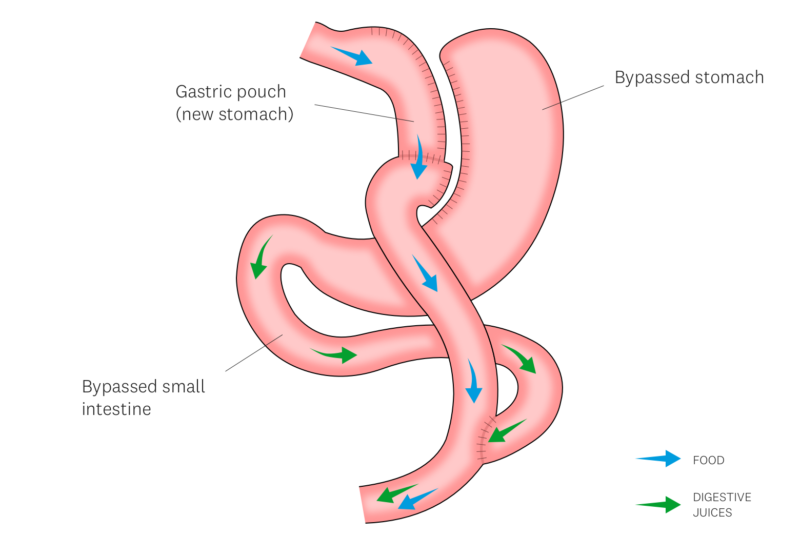Roux en Y Gastric Bypass (RNYGB)
Over the past 50 years, Roux en Y gastric bypass has become a powerful tool for weight loss.
When is Roux en Y gastric bypass surgery considered?
- as a primary operation, with a BMI>35
- as a revisional procedure, if you’ve had a previous bariatric procedure such as a gastric band, gastric sleeve, or endoscopic sleeve gastroplasty
During your initial consultation, there may be some reasons in your medical history, which may make this operation unsuitable. If this is the case, an alternative operation will be suggested.
Here’s how it works:
1. Reshaping your stomach: A small pouch is created from your existing stomach, significantly reducing its volume. This drastically limits the amount of food you can comfortably eat, leading to earlier feelings of fullness and reduced calorie intake (restriction).
2. Rerouting the small intestine: A section of your small intestine is bypassed, preventing food from reaching the first part of it and the original stomach. This reduces the surface area available for nutrient absorption, leading to some malabsorption of calories and nutrients.
3. Hormonal shifts: The surgery influences gut hormones that regulate hunger and satiety, further contributing to reduced appetite and increased feelings of fullness.
Combined, these effects create a potent approach to weight loss. On average, patients undergoing Roux-en-Y gastric bypass experience a 70% loss of their excess weight. However, it’s crucial to remember that individual results vary.

Beyond weight loss, Roux en Y gastric bypass can offer significant benefits:
- Significant and sustained weight loss: On average, patients lose 70% of excess weight, potentially improving mobility and energy levels.
- Improved health: Remission or improvement in related conditions like diabetes, sleep apnea, high blood pressure, and joint pain.
- Reduced cancer risk: obesity is linked to certain cancers, and the surgery may offer a protective effect.
- Lower risk of heart attack and stroke: Addressing obesity can lessen the risk of these vascular events.
- Longer lifespan: Achieving a healthy weight can potentially increase life expectancy.
- Enhanced quality of life: Improved mobility, energy, relationships, and employment opportunities.
Remember, everyone is unique. While the average patient loses 70% of excess weight, individual results may vary due to factors like starting weight, commitment to lifestyle changes, and underlying health conditions.
While complications are infrequent, they can occur, and include:
- Anastomotic leak – stomach fluid may leak out into the abdomen at either of the two joins created during this procedure, due to failure of the joins to heal. This may require further surgery/procedures and a prolonged hospital stay.
- Marginal ulceration – this is an erosion/ulcer of the small bowel joined to the gastric pouch, similar to a stomach ulcer. This may cause pain in the upper abdomen or chest. Most times this can be treated with medications. Occasionally, this requires revisional surgery.
- Stomal stenosis – a narrowing at the join between stomach and small bowel. You may develop vomiting and rapid weight loss due to inability of food and/or fluids to pass through the narrowed area. This may require stretching up with a balloon, or placement of a stent (tube) and removal 4 weeks later. Occasionally, this requires revisional surgery.
- Stomal dilation – a widening at the join between stomach and small bowel. You may be able to eat more. This may be fixed by narrowing the opening with stitches endoscopically (via a scope placed through the mouth). Occasionally, this may require revisional surgery.
- Internal Hernia – bowel may get trapped in spaces created during the formation of the gastric bypass, even though these spaces are routinely closed. This may cause a blockage of the small bowel (obstruction) or lead to a lack of blood supply to the small bowel (strangulation). This is an emergency. You must go to your local hospital immediately if you have significant abdominal pain lasting more than one hour, with or without vomiting.
- Dumping syndrome – a cluster of symptoms including Nausea/vomiting, rapid heartbeat, sweating, flushing, light-headedness, abdominal cramps, and diarrhoea. This is usually due to eating too much or eating foods high in sugar. This can be fixed by modifying your eating habits.
- Nutritional deficiencies – even though you will need to take multivitamin supplements, you may become low in certain vitamins or minerals. You may need additional supplementation. You will require lifelong follow-up and blood tests to monitor for potential deficiencies.
Want to continue your Roux en Y gastric bypass journey?